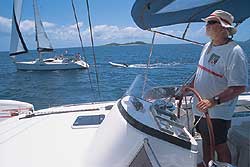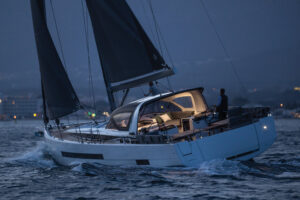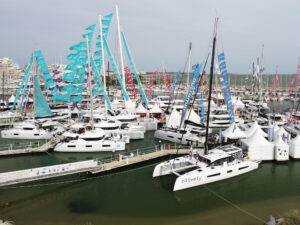For those of us with a bit of brine in our veins, its slightly disconcerting at first to charge around unfamiliar, reef-strewn tropical islands at 10 or 12 knots without concern for grounding, dragging anchor in a thunderstorm, conking somebodys head in an accidental jibe, puncturing the inflatable at night on the way back from the beach bar, nursing some neophyte through mal de mer, or even spilling a little drinking water on the furniture. Odd, maybe, but you get used to it. Few things, it seems, are as seductive in combination as luxury and the utter absence of personal responsibility.
|
|
| |
|

|
| |
| Herb McCormick|
| |
|
|
| |
| The author is at the helm of one of The Moorings’ new Jacques Feroux-designed 54-foot monohull sloops, Kwa Heri.* * *|
| |
|
|
| Wed reveled in both of these features during a week of stress-free cruising in the British Virgin Islands aboard a gleaming dance hall of a vessel named Good Vibrations. Built by South Africas Robertson & Caine and designed by Alex Simonis as the Leopard 62, she was one of the new 62-foot catamarans offered for charter by The Moorings out of Tortola. Called Moorings 6200s, these air-conditioned palaces have professional captains and crews and four cabins for guests (each with private shower, head, flat-screen TV, and personal DVD player), plus yawning great saloons and cockpits for entertaining, space-age flying bridges from which to steer and navigate, and the heft of an ocean liner.
Multihull vs. Mono
The objective of our trip was to test the latest additions to The Moorings’ Tortola fleet, the 62-foot cat and a slippery, new, 54-foot crewed monohull, Kwa Heri, designed by Jacques Faroux. Moorings president Lex Raas and his wife, Carol, tagged along for a few days to point out some improvements, mostly creature comforts, they’d helped design into both boats.
But it fast emerged that Lex, 48, had been a racing sailor back in his native South Africa, as were a few others on our patched-together crews. Naturally, with a handful of competitive people aboard, the best-laid plans went straight to hell, and it turned into the 1988 Americas Cup all over again, with Good Vibrations playing the role of Dennis Conners monster catamaran, Stars and Stripes, fighting off the challenge of New Zealand, the Kiwi monohull played by Kwa Heri. The results were about the same: another horizon job for the cat.
It was, in fact, a bit dispiriting for the single-hull traditionalists among us to see how convincingly Good Vibrations put away Kwa Heri, even upwind, where multihulls are meant to struggle. The first days sail up to Virgin Gorda was a beat in choppy seas. Kwa Heri skipper Peter Whitney did a nice job playing the wind shifts out of Road Town and briefly stuck his nose out front. But once into green water, Good Vibrations skipper Patrick Phelan cracked off a few degrees, rolled out the big sails, and sped from under Kwa Heris lee. He had sails furled and was helping guests select snorkeling masks by the time the monohull fetched up.
How stable was Good Vibrations? Unpacking my duffel the first morning, I noticed a slender, one-liter bottle of drinking water left by my bunk. I thought to stow it before we got going lest it fly around the cabin when we heeled or hit a chop. But I forgot, and that evening, after a lively, 10-mile sail up to Virgin Gorda in 15 to 20 knots of wind, I was amazed to see the bottle still standing upright on the table, drinking cup still in place atop it.
I had a glass of water that night–and for five succeeding nights–until the bottle was dry, and out of stubbornness, I kept putting it back on the same perch, waiting for it to topple as it grew ever lighter. It never did, nor did it even move an inch, as far as I could tell. The catamaran stayed as level as a barge come wind or wave, and it was, I thought, time to rewrite the sailing books. Id drunk the bottle to the dregs–with no humiliation!
Which is the whole idea with this latest breed of big, crewed charter cat that provides the experience of big-water sailing without the nettlesome worries and inconveniences that normally accompany it. Its about making guests, including novices and complete nonsailors, feel comfortable and safe.
The revelations of the first day were a mere prologue to Day Two, a 14-mile downwind run to beautiful, remote Anegada that proved much more painful for the monohull as it dropped so far behind that it fell out of sight.
Kudos to Kwa Heri
We consoled Peter and his wife and first mate, Darcy, with assurances that all of us from a sailing perspective still preferred the look and feel of the monohull to the cat, and it wasn’t just idle talk. The Moorings 554 Kwa Heri, with her deep keel, tall rig, and shapely hull, sent all the right signals back through her twin steering wheels, encouraging the tweaking of sails and adjustment of trim to get the right degree of heel, weather helm, balance, and speed for the ever-changing breeze and sea conditions. She’s a real sailor’s boat.
Good Vibrations, for all her performance advantages, “might as well be on rails,” conceded Lex, whos convinced that spacious catamarans will continue to increase their share of the charter market, which is already up to about 30 per cent. “I expect in the end it will be 50/50, monohulls and cats,” he said.
In any event, Kwa Heri had to get back to the yard in Tortola after the first few days of trials to complete fitting out for her maiden charter the following week, so everyone piled onto the cat for the remaining days. We bade farewell to the Whitneys with a sunset dinner of fresh Anegada lobster, but they were too anxious about their upcoming work to stick around and eat it, which left more for the rest of us. No complaints there. If you havent had Anegada lobster, split and marinated in a vinaigrette dressing, then roasted to perfection on the grill, you still have something left to live for.
So began an idyllic four days cruising the big cat through the warm, aqua and indigo waters from Anegada to Green Cay to Jost Van Dyke to the Indians to the Bight at Norman Island and back to Road Town, a time during which our little group of do-it-yourself monohullers explored the advantages of multihulls and of chartering under the skeptical gaze of a professional skipper. It was an eye-opener all around.
Meet the Crew
Four of us were left standing after Lex and Carol took their leave with the Whitneys. This meant plenty of room to roam on mighty Good Vibrations, which, with a beam of 30 feet, has considerably more living space than your average New York apartment. Ours was a mixed crowd in terms of experience, ranging from Caroline–a sailing newcomer more at home on the back of a show horse in her native Baltimore, Maryland–to Paul–a rough-cut firefighter from Newport, Rhode Island, who specializes in water rescues and once spent a year at sea working on a motoryacht for gangsters–to me–a moderately experienced big-water sailor and racer–to, finally, Andy–my Annapolis yachting partner, who was a keen and talented dinghy racer in college and now steers big boats in some of the more competitive U.S. events. This latter show-off turned up for breakfast every day in a new shirt advertising some fancy regatta he’d been in.
Each of us, in one way or another, was used to calling his or her own shots, so it was a bit of an adjustment to be under the pitiless glare of Patrick Phelan, a tall, droll, 41-year-old South African whose fundamental rule was “You can do anything you like on the boat, but only if I say so.” He proved a skillful boathandler with a wry wit and seemingly boundless doubts about the fitness of anyone besides the first mate–cheerful Brit Sarah Barrett, whom we dubbed Lady Sarah–to do anything, particularly if it looked in the least like work. It took Andy and me four days to convince him we could be trusted to load a line around a winch the right way.
The skipper set the tone when I first stepped aboard at The Moorings base, where more than 200 charter boats are docked. I found Good Vibrations still dripping with the final spritzes from the washdown hose and leaped on, jumping over a pile of boat shoes on the dock. It only occurred to me why they were there when we did the introductions and I glanced down to see I was the only one still shod, with a small, dirty puddle at my feet. “Sorry about that,” I told Patrick. “I guess I should have taken my shoes off.”
“That’s quite all right,” he said wearily. “I’ll just do it all over again.”
Amazing Grace
The hardest thing about designing big cruising catamarans, said Lex, is getting them to look sleeker than a shoebox. In that respect, the Moorings 6200 shines, and she was the belle of all multihulls in every anchorage we visited. It’s not hard to be better looking than the average 35- or 40-foot cruising cat, of course, but the 6200’s louvered forward cabin ports, its shapely tinted side ports, its flared spray deflectors along the hull sides, and its prodigious length give it a certain (dare I say it?) rakish grace. No kidding!
The second-hardest thing, said Lex, is to make a flybridge work on a cat. Usually they end up so high they look like big, boxy crows nests and force the boom and mainsail too far aloft. But by engineering a healthy step down into the main cabin below, The Moorings managed to lower the whole assembly atop it so it looks appropriate. And by leading all control lines to the control tower aloft, they kept the cockpit below clear for more important stuff (cocktails and hors doeuvres) and gave the driver and his helpers lofty and sweeping control of the action.
As for luxurious appointments, can you say “over the top”? In addition to providing every bell and whistle–from the flat-screen DVD players to individual controls over air-conditioning in each cabin to an infinitely adjustable drink blender–Lex said his goal was to create padded nooks and crannies all around the boat to which folks could escape, where they could read or sightsee and get away from their crewmates. “On a one-week charter with four couples,” he said, “we find for the first two days that everybody gets along great, but after that, you start looking for a little privacy.” Good Vibrations has enough room that you can find a comfy cubby to tuck into where you cant even see anyone else.
On the matter of performance, with twin 240-horse diesels plus air conditioners, generators, fuel tanks, watermaker, and heaven knows what all else, the 6200 weighs in at a ponderous 65,000 pounds. That means, as Phelan puts it, “If you ever do get powered up enough to raise a hull, youre in deep trouble.” Still, even dead level, with its working sail area of 2,218 square feet, the cat can sail upwind at 9 1/2 knots and run off the breeze in the double digits, which isnt slow by any measure. Or it can rumble along all day at 12 knots under power. See ya!
The Anegada Option
The British Virgins are a cruising sailor’s Disneyland. The islands are close enough together that navigation is by line of sight, every decent port is dotted with rental moorings so you don’t have to worry about anchoring overnight, day anchorages alongside uninhabited cays are incredibly beautiful, the reef diving is superb, and enough funky beach bars are around that you’ll never spend a thirsty or sober night–unless you want to.
On the other hand, theres a certain shopworn feel to the place once the initial delirium of warm winds and bright waters wears off the winter-weary charterer. The B.V.I. standard circuit from Tortola to Virgin Gorda to Jost van Dyke to Norman and Peter islands, with diving stops and beach bars along the way, is safe and eye appealing, and the wind blows steady almost every day. But it all feels a bit, I dont know, familiar. Which is where Anegada comes in.
The northernmost island in the chain, its just out of sight of the others, so you must actually plot a course to get there. And its low, unlike its mountainous sisters, with its highest point just 28 feet above sea level. It has generally been off-limits to charterers because of dangerous reefs around it, but most companies now are easing restrictions because global-positioning equipment gets crewed charters and bareboaters alike in more safely. The upshot is a new and refreshingly unspoiled place, particularly if you hail a rattletrap cab for $6 a person and ride out from the harbor to Loblolly Beach. Inaccessible by boat, Loblolly has an uncrowded beach bar that overlooks the best diving Ive encountered anywhere in the B.V.I.
The coral heads on Loblollys close-in reef have a pristine look, with deep nooks and crannies where big fish lurk. We swam behind a sea turtle for quite a while, then chased a three-pound lobster into a lair, where it menaced us with its antennae. We found jumbo yellowtail snappers and multihued groupers in abundance, beautiful spiny urchins in black and white, and colorful reef fish by the thousands, all within an easy swim of the nearly empty sand beach.
On top of all that, Anegada is justifiably famous for its lobsters, readily available live from local fishermen or precooked from the little hotel there. They make for a spectacular meal. All of which is to say that there actually is something new under the B.V.I. sun, and anyone chartering in the islands should press for permission to make the trek to Anegada. You wont be disappointed.
And So, the Verdict
Performance: From a performance standpoint, the cat-vs.-mono trial was no contest. Put a well-designed catamaran up against a cruising-oriented monohull of a similar length, and the cat will almost always get to the next stop first.
Comfort and convenience: From this point of view, its more of the same. The pretty, 54-foot Kwa Heri felt like a real seagoing boat down below, with tight cabins up forward and an elegant and intimate saloon decked out in dark, varnished wood amidships. Good Vibrations, by contrast, felt like a very expensive seaside hotel, with acres of room to spread out in and get away from your boat buddies. The only thing missing was a pool, which wasnt a problem, given the gin-clear waters off the swim platform astern.
That seagoing feeling: But does it look like a boat or feel like a boat under way? The answer, plain and simple, is no. Big cats are perfect platforms for folks who want to get out and feel the wind on their faces and the spray in the air, then repair to a plush, air-conditioned lounge when the sun goes down–but dont get off on all the heeling and bashing.
As for me, give me a heeling, pitching sloop charging to weather with the lee rail plowing under in the puffs, and Ill gladly sleep on a pile of sail bags in my foul-weather gear and eat freeze-dried food with my bare hands.
The B.V.I.: Its hard to say anything bad about sailing in the British Virgin Islands. The wind blows 15 to 20 knots most days, steady and generally from the same direction–east. The weathers warm, the waters clear, the islands are green and largely unpopulated, the dangers are few, and the pleasures are many.
As a result, one of the biggest charter fleets anywhere in the world has sprung up over the last 35 years, with hundreds of monohulls and catamarans all plying the same water. If theres a downside to that, its that the islanders seem to be getting a bit weary of all the entertaining, and they arent always the most cheerful hosts in the world. Thus, almost everyone you meet socially is another charterer doing the same thing you are.
Thats not all bad, considering that the thing youre all doing is trying to cram as much fun as possible into a week or so, pursuing what you all love best in a wonderful place. What do you want, as we used to say back home on Long Island, egg in your beer?
The final word: Our skipper, the droll South African Patrick, gave us just one assignment during our stay, which was to write a poem about our experience and enter it in his logbook, as had all his previous charter parties. Being the professional writer, the job fell to me. So here it is, with apologies to Walt Whitman:
O Captain! my Captain!
The fearful trip is quits,
Our guts are stretched as tight as drums,
Our minds gone soft as grits.
We’ve learnt our lesson at your throne:
Touch only fridge or wheel;
All else, if it pertains to work,
Is Lady Sarah’s deal.
But O heart! heart! heart!
O my God, I’ve lost my drink!
We’ll tell the skipper, he’ll make more.
Cin-cin, brave shipmates.
Clink!
Frequent CW contributor Angus Phillips is the outdoors columnist for The Washington Post and lives in Annapolis, Maryland.








